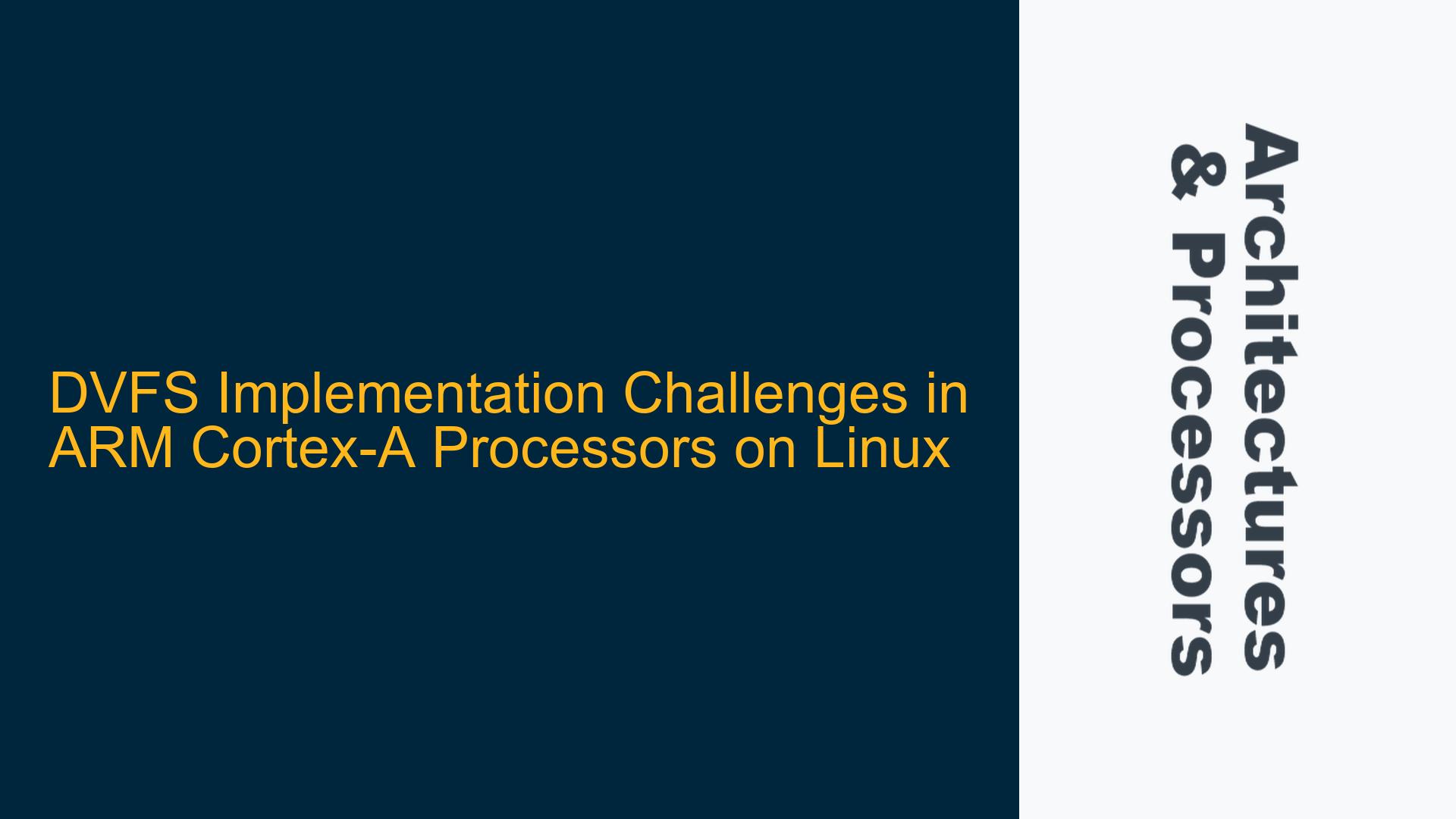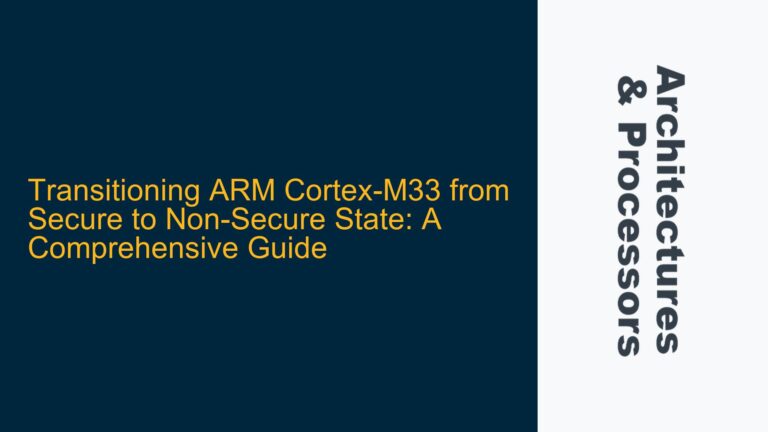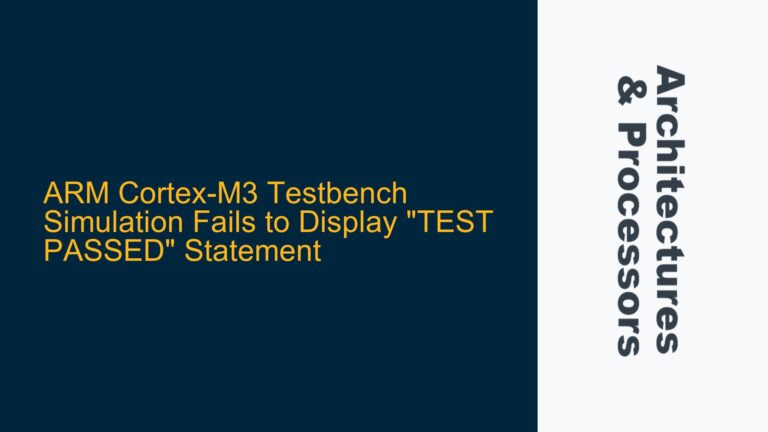Dynamic Voltage and Frequency Scaling (DVFS) in ARM Cortex-A Processors
Dynamic Voltage and Frequency Scaling (DVFS) is a critical technique for optimizing power consumption and performance in modern embedded systems, particularly in ARM Cortex-A processors like the Cortex-A7 and Cortex-A15 found in the Odroid-XU3 board. DVFS allows the system to dynamically adjust the operating voltage and frequency of the processor cores based on the workload, enabling a balance between performance and energy efficiency. However, implementing DVFS in a Linux C environment on ARM Cortex-A processors presents several challenges, including understanding the underlying hardware capabilities, leveraging the appropriate Linux kernel APIs, and ensuring proper synchronization between hardware and software.
The Cortex-A7 and Cortex-A15 cores in the Odroid-XU3 board are part of ARM’s big.LITTLE architecture, which combines high-performance cores (Cortex-A15) with energy-efficient cores (Cortex-A7) to optimize power consumption and performance. The Cortex-A15 cores are designed for high-performance tasks, while the Cortex-A7 cores handle lighter workloads, making them ideal for energy-efficient applications. However, the implementation of DVFS in such a heterogeneous multi-core system requires careful consideration of the hardware capabilities and the software interfaces provided by the Linux kernel.
Linux Kernel APIs and DVFS Management in ARM Cortex-A Processors
The Linux kernel provides several APIs and mechanisms for managing DVFS in ARM Cortex-A processors. One of the primary interfaces for DVFS management is the CPUFreq subsystem, which allows the system to adjust the frequency of the processor cores dynamically. The CPUFreq subsystem supports various governors, such as the ondemand governor, which adjusts the CPU frequency based on the current workload, and the performance governor, which keeps the CPU frequency at the maximum level for optimal performance.
In addition to the CPUFreq subsystem, the Linux kernel also provides the CPUIdle subsystem, which manages the idle states of the processor cores. The CPUIdle subsystem allows the system to put the processor cores into low-power states when they are not in use, further reducing power consumption. However, the interaction between the CPUFreq and CPUIdle subsystems can be complex, particularly in a big.LITTLE architecture where the high-performance and energy-efficient cores have different power and performance characteristics.
To implement DVFS in a Linux C environment, developers need to interact with these kernel subsystems using the appropriate APIs. For example, the CPUFreq subsystem provides a set of sysfs interfaces that allow user-space applications to query and control the CPU frequency. Similarly, the CPUIdle subsystem provides sysfs interfaces for managing the idle states of the processor cores. However, using these interfaces requires a deep understanding of the underlying hardware and the Linux kernel’s power management mechanisms.
Synchronization and Performance Bottlenecks in DVFS Implementation
One of the key challenges in implementing DVFS in ARM Cortex-A processors is ensuring proper synchronization between the hardware and software. The dynamic adjustment of the CPU frequency and voltage can introduce latency and performance bottlenecks, particularly in real-time applications where timing is critical. For example, if the CPU frequency is reduced too aggressively, the system may not be able to meet the performance requirements of the application, leading to degraded performance or even system failures.
To mitigate these issues, developers need to carefully tune the DVFS parameters, such as the frequency scaling thresholds and the transition latency between different frequency levels. This requires a thorough understanding of the workload characteristics and the performance requirements of the application. Additionally, developers need to consider the impact of DVFS on other system components, such as the memory subsystem and the I/O devices, which may also be affected by changes in the CPU frequency and voltage.
Another potential source of performance bottlenecks in DVFS implementation is the interaction between the high-performance and energy-efficient cores in a big.LITTLE architecture. In the Odroid-XU3 board, the Cortex-A15 and Cortex-A7 cores have different power and performance characteristics, and the system needs to ensure that the workload is properly balanced between the two types of cores. This requires careful tuning of the task migration policies and the frequency scaling thresholds to ensure that the system can achieve the desired balance between performance and energy efficiency.
Best Practices for Implementing DVFS in ARM Cortex-A Processors on Linux
To successfully implement DVFS in ARM Cortex-A processors on Linux, developers should follow a set of best practices that address the challenges discussed above. First, developers should thoroughly understand the hardware capabilities of the target platform, including the power and performance characteristics of the processor cores and the available frequency and voltage levels. This information is typically provided in the technical reference manual (TRM) for the processor and the board.
Next, developers should familiarize themselves with the Linux kernel’s power management mechanisms, including the CPUFreq and CPUIdle subsystems. This includes understanding the available governors, the sysfs interfaces for controlling the CPU frequency and idle states, and the interaction between the two subsystems. Developers should also consider using the Linux kernel’s tracing and profiling tools, such as ftrace and perf, to monitor the system’s performance and identify potential bottlenecks.
When tuning the DVFS parameters, developers should start by analyzing the workload characteristics and the performance requirements of the application. This includes identifying the critical sections of the code that require high performance and the sections that can tolerate lower performance. Based on this analysis, developers can set appropriate frequency scaling thresholds and transition latencies to ensure that the system can meet the performance requirements while minimizing power consumption.
In a big.LITTLE architecture, developers should also consider the task migration policies and the frequency scaling thresholds for the high-performance and energy-efficient cores. This includes ensuring that the workload is properly balanced between the two types of cores and that the system can dynamically adjust the frequency and voltage levels based on the current workload. Developers should also consider using the Linux kernel’s energy-aware scheduling (EAS) framework, which is designed to optimize power consumption in heterogeneous multi-core systems.
Finally, developers should thoroughly test the DVFS implementation to ensure that it meets the performance and power consumption requirements of the application. This includes testing the system under different workload scenarios and monitoring the system’s performance and power consumption using the Linux kernel’s tracing and profiling tools. Developers should also consider using hardware performance counters to gather detailed information about the system’s behavior and identify potential bottlenecks.
Conclusion
Implementing DVFS in ARM Cortex-A processors on Linux is a complex task that requires a deep understanding of the hardware capabilities, the Linux kernel’s power management mechanisms, and the performance requirements of the application. By following the best practices outlined above, developers can successfully implement DVFS in their applications and achieve the desired balance between performance and energy efficiency. However, developers should also be aware of the potential challenges and performance bottlenecks associated with DVFS implementation and take appropriate measures to mitigate these issues. With careful planning and thorough testing, developers can leverage the power of DVFS to create energy-efficient applications that meet the performance requirements of modern embedded systems.






